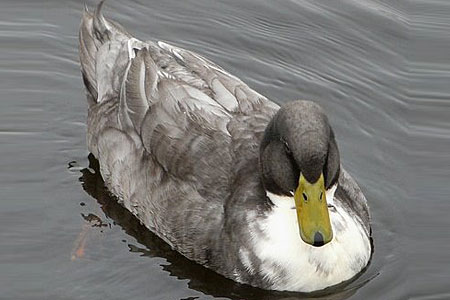
The Swedish duck has its origins in the early to mid 1800s in Pomerania, a region on the Baltic Sea that was once controlled by Sweden. The breed first came to the United States in 1884. The only variety listed in the American Standard of Perfection is the blue variety, accepted in 1904.
Physical Attributes
Blue Swedish ducks are slate blue with a white bib and sometimes a few white wing feathers. The drake’s head is a darker blue and he has a greenish bill. The hen’s head and bill, on the other hand, are the same color as her body.
The blue plumage color results from an incompletely dominant gene that requires a combination of two alleles (variations of the same gene). Blue Swedish ducks therefore do not breed true.
Mate a blue to a blue and you will get only 50% blue ducklings. Half of the remaining ducklings will be black and the other half splash.
To get 100% blue ducks requires crossing black with splash. Even then, Blue Swedish ducks are not all the same shade of blue.
Black Swedish ducks are more common than blues. They are similar to the Blue Swedish, only black instead of blue.
In contrast to Blue and Black Swedish, no two Splash Swedish ducks are alike. Their plumage is a mixture of whites and shades of blue, resulting in an overall appearance of being light gray.
The legs of a Swedish duck are set farther back than those of most other domestic duck breeds. As a result, the Swedish duck has a somewhat upright stance, similar to that of a Campbell duck.
Breed Qualities
Swedish ducks are slow maturing and are relatively small — ducks reach a weight of 5 pounds, drakes 6¼ pounds. The hens are moderately prolific layers, producing 120 to 180 large to extra large eggs per year. The shells are typically white, although the eggs of some Swedish ducks have greenish shells. The hens will brood and are conscientious mothers.
Swedish ducks are particularly active and therefore don’t tolerate close confinement. They are good foragers, and their plumage color makes them somewhat resistant to predation. Although they can fly, they usually prefer not to.
The Swedish duck is exceptionally cold tolerant and among the hardiest of duck breeds. With its calm temperament, it makes a wonderful outdoor pet, especially for kids. The Swedish duck is also popular for exhibition and as an ornamental.
Helpful Links
- Keeping Ducks for Eggs
- How to Keep Your Ducks Laying Well
- How the Eggs of Chickens, Turkeys, Ducks and Geese Compare
- How to Handle Duck Eggs for Eating
And that’s today’s news from the Cackle Coop.
Gail Damerow is the author of An Absolute Beginner’s Guide to Raising Backyard Ducks : Breeds, Feeding, Housing and Care, Eggs and Meat.

